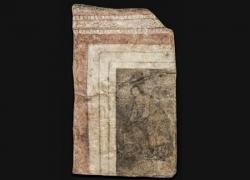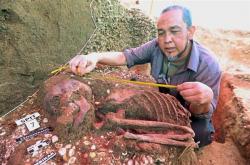INSTITUT SUPERIEUR D'ANTHROPOLOGIE
INSTITUTE OF ANTHROPOLOGY
ONLINE COURSES / COURS A DISTANCE
SPRING TERM : APRIL 2017
REGISTER NOW
ROYAUME UNI –  Caithness - Archaeologists are excavating the site of what is thought to be an Iron Age home known as a wag. A small scale excavation was done at Burn of Swartigill south of Wick in Caithness in 2015. A copper alloy fragment thought to have been part of a brooch possibly worn by a person of high status was among finds made two years ago. Finds made so far include a fragment of ceramic pottery. The dig has also begun uncovering a stone structure. Wags are Iron Age buildings found elsewhere in Caithness and neighbouring Sutherland. Their construction began after a period of broch-building. Brochs were large stone towers and remains of them can be found across the Highlands and in the Northern Isles.
Caithness - Archaeologists are excavating the site of what is thought to be an Iron Age home known as a wag. A small scale excavation was done at Burn of Swartigill south of Wick in Caithness in 2015. A copper alloy fragment thought to have been part of a brooch possibly worn by a person of high status was among finds made two years ago. Finds made so far include a fragment of ceramic pottery. The dig has also begun uncovering a stone structure. Wags are Iron Age buildings found elsewhere in Caithness and neighbouring Sutherland. Their construction began after a period of broch-building. Brochs were large stone towers and remains of them can be found across the Highlands and in the Northern Isles.
http://www.bbc.co.uk/news/uk-scotland-highlands-islands-39703952
ROYAUME UNI –  Thorne - The investigation is taking place on land next to a medieval castle mound on Church Street. To date, evidence of the post-medieval period has been found, including building foundations, wells and animal burials, as well as fragments of pots, pipes, and glassware left behind by long-ago residents of the site. Surprisingly, the team have yet to find signs of any medieval activity. Archaeologists will continue their search for evidence of medieval Thorne by excavating a trench across the bank and moat around Peel Hill, from May 8 onwards.
Thorne - The investigation is taking place on land next to a medieval castle mound on Church Street. To date, evidence of the post-medieval period has been found, including building foundations, wells and animal burials, as well as fragments of pots, pipes, and glassware left behind by long-ago residents of the site. Surprisingly, the team have yet to find signs of any medieval activity. Archaeologists will continue their search for evidence of medieval Thorne by excavating a trench across the bank and moat around Peel Hill, from May 8 onwards.
http://www.thestar.co.uk/news/dig-reveals-relics-of-bygone-doncaster-1-8510813
SYRIE –  Dura-Europos - A team of Yale University archaeologists excavated a site at Dura-Europos in the 1920 and discovered what is now known as the oldest existing Christian Church in the world. What they found there changed everything. The team discovered a painting of a woman leaning over a well. Believing it was just another piece of art, the team took the painting and it has been kept in the Yale University Museum ever since. Most believe the painting is a reference to the Samaritan woman who speaks to Jesus at the well, a story which can be found in John 4:1-42, but the Biblical Archaeology Review scholar Mary Joan Winn Leith believes the image is something very different. Leith reviewed scholar Michael Peppard's argument that the portrait is that of the Virgin Mary at the moment of the Annunciation, when Gabriel tells her she will bear the Son of God. Peppard originally stated the wall painting is actually a depiction of Mary looking to see where the angel Gabriel's voice was coming. Leith explained: "Among the puzzles is how Christians viewed Jesus' mother Mary in the earliest centuries of Christianity. Mary's status in Christianity only became official in 431 when the Council of Ephesus awarded her the title Theotokos, 'the one who gives birth to God.' "Information about Mary's significance before then, whether visual or textual, is surprisingly sparse, but archaeology has supplied some helpful clues."
Dura-Europos - A team of Yale University archaeologists excavated a site at Dura-Europos in the 1920 and discovered what is now known as the oldest existing Christian Church in the world. What they found there changed everything. The team discovered a painting of a woman leaning over a well. Believing it was just another piece of art, the team took the painting and it has been kept in the Yale University Museum ever since. Most believe the painting is a reference to the Samaritan woman who speaks to Jesus at the well, a story which can be found in John 4:1-42, but the Biblical Archaeology Review scholar Mary Joan Winn Leith believes the image is something very different. Leith reviewed scholar Michael Peppard's argument that the portrait is that of the Virgin Mary at the moment of the Annunciation, when Gabriel tells her she will bear the Son of God. Peppard originally stated the wall painting is actually a depiction of Mary looking to see where the angel Gabriel's voice was coming. Leith explained: "Among the puzzles is how Christians viewed Jesus' mother Mary in the earliest centuries of Christianity. Mary's status in Christianity only became official in 431 when the Council of Ephesus awarded her the title Theotokos, 'the one who gives birth to God.' "Information about Mary's significance before then, whether visual or textual, is surprisingly sparse, but archaeology has supplied some helpful clues."
http://www.catholic.org/news/hf/faith/story.php?id=74653
MALAISIE –  Guar Kepah - She came from a civilisation that obviously ate a great deal of molluscs and her people must have loved them. They accumulated millions of seashells from their diet and buried their dead in them. This discovery in Guar Kepah may lead to a change in our history of the land as other instances of ancient humans burying their dead in seashells are only found in far-off places like Senegal, Africa. This is the first time in Malaysia that a Stone Age human was confirmed to be buried in seashells, said Universiti Sains Malaysia (USM) archaeologist Prof Datuk Dr Mokhtar Saidin. “We know she lived 5,000 to 6,000 years ago. We will soon narrow it down to the precise century after carbon dating the samples,” he said.He said the burial site was likely also a shell midden and the mounds of shells grew to about 5m high. “Her body was buried lying down sideways on a bed of seashells mixed with some soil and covered by a large mound of more seashells,” Dr Mokhtar said. Three earthen pots were found beside her, but their contents – believed to be what this ancient race thought she would need in the afterlife – are long gone. He said the skeleton was well-preserved because a kampung house was built on top of it, keeping out heat and moisture. “We will take the skeleton to USM to confirm the gender, age, illness, cause of death and genetic roots.
Guar Kepah - She came from a civilisation that obviously ate a great deal of molluscs and her people must have loved them. They accumulated millions of seashells from their diet and buried their dead in them. This discovery in Guar Kepah may lead to a change in our history of the land as other instances of ancient humans burying their dead in seashells are only found in far-off places like Senegal, Africa. This is the first time in Malaysia that a Stone Age human was confirmed to be buried in seashells, said Universiti Sains Malaysia (USM) archaeologist Prof Datuk Dr Mokhtar Saidin. “We know she lived 5,000 to 6,000 years ago. We will soon narrow it down to the precise century after carbon dating the samples,” he said.He said the burial site was likely also a shell midden and the mounds of shells grew to about 5m high. “Her body was buried lying down sideways on a bed of seashells mixed with some soil and covered by a large mound of more seashells,” Dr Mokhtar said. Three earthen pots were found beside her, but their contents – believed to be what this ancient race thought she would need in the afterlife – are long gone. He said the skeleton was well-preserved because a kampung house was built on top of it, keeping out heat and moisture. “We will take the skeleton to USM to confirm the gender, age, illness, cause of death and genetic roots.
VIDEO = http://www.thestar.com.my/news/nation/2017/04/25/a-find-that-can-change-history-stone-age-remains-buried-in-seashells-the-first-to-be-found-in-malays/
CHINE - Liuyang - Archaeologists in central China's Hunan Province are excavating a site of a porcelain kiln to make way for a new railway. The Yanquan kiln, on a hill in Shantian village, Liuyang city, was used between the Southern Song Dynasty (1127 - 1279) and the Yuan Dynasty (1271 - 1368), said Xun Chunlin, curator of the Liuyang city museum on Monday. Archaeologists have found a kiln workshop, a pit for storage of the clay used in porcelain making, two channels and three walls. They have unearthed porcelain utensils, mostly greenish white, and tools used in the kiln. "Although it was an unofficial kiln, the excavation helps us learn more about life of people in the Song and Yuan dynasties," Xun told Xinhua. "It also demonstrates the spread of porcelain making from east China to Hunan," he said. The kiln, discovered in 1984, is on the route of a railway linking Inner Mongolia and Jiangxi Province, intended to be a major coal transportation line, stretching more than 1,800 kilometers and scheduled to begin operations in 2020.
http://www.china.org.cn/arts/2017-04/24/content_40685530.htm